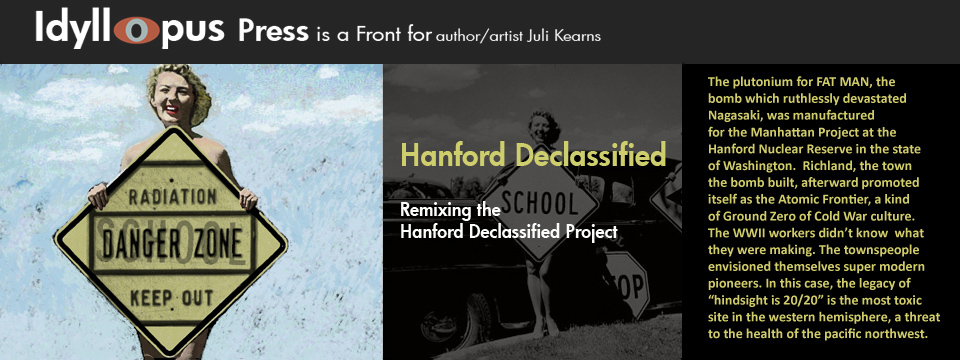Model for Instrument Show Publicity Shot, Declassified
Digital painting, 2007
30 by 24 in.
Read the introduction to the Remixing the Hanford Declassified Project paintings
The painting is based on a photograph from the Hanford Declassified Project. Hanford, part of the Manhattan Project, was where the plutonium used on Nagasaki was manufactured. In 1953, the year of the photo on which the painting is based, was begun a second Cold War expansion of the site, with the oldest reactors by then operating at 20% to 50% above design capacity.
Blastoise, a turtle Pokemon, is perched on the model's sexy lure of hip. However he got there, I don't know, he just kind of appeared in this painting. With his water cannons he could be an evolution from a painting I'd done prior this one, based on a Hanford fire safety photo showing a woman putting out a trash can fire with a water hose. What I do know is that should his weaponry fail to protect him, though the little turtle tank portable shelter would seem an enviable security, much as bomb shelters seemed to individuals during the Cold War (and their equivalent to today's survivalists), they offer little more protection than shielding one from the truth.
On August 9, 1945 Fat Man was detonated over Nagasaki.
Sixty-two years later, American school children are still being taught the bombings were necessary, that they ended the war and saved many lives. That Fat Man and Little Boy were warranted, no matter the consequences.
Sixty-two years later, the tanks holding radioactive waste at Hanford are leaking, an environmental catastrophe of which the general public is still largely ignorant.
Unfortunately, today the Hanford Nuclear Reservation is one of the most radioactive places in the world. Little was known about the dangers of nuclear waste in the 1950's and '60s when the place was at its peak of production, and disposal methods were primitive. For years, the chosen disposal method for the tons of toxic industrial chemicals and highly radioactive slurry needed to produce just one pound of plutonium was to put the stuff in single shelled underground tanks or to bury it in barrels in unlined trenches. Over the last 50 years an estimated 440 billion gallons of contaminated liquids were directly disposed of by pouring them into the ground.
The site now contains 177 underground storage tanks in a huge "tank farm," holding millions of gallons of high-level radioactive waste in a soup of highly corrosive chemicals and potentially explosive. At least 67 of these underground tanks have leaked at least one million gallons of highly radioactive waste into the groundwater. More tanks begin leaking each year as they continue to corrode. More than 200 square miles of Hanford's groundwater aquifer have now been contaminated. Further contamination comes from 2,300 tons of corroded spent nuclear fuel rods held in two water-filled basins less than 500 yards from the Columbia River. The place is one huge Superfund toxic waste site, which the law requires the federal government to clean up...
...When Hanford was in its production heyday in 1964, contaminated water used to cool nine plutonium production reactors was also carrying radioactive wastes far downstream. Contaminated groundwater first reached the Columbia River in the 1950's. During that decade filter-feeding shellfish well down the Pacific coast, well south of the Columbia estuary, started showing up with very high radiation levels from short-lived isotopes that could only have originated at Hanford. In 1954 alone it was estimated that almost 3 million curies of radiation were released directly or indirectly into the river from the Hanford facility.
- The Pacific Coast Federation of Fishermen's Associations

Here is another photo from the same shoot that I did a post on last year.
Originally posted on my blog Aug 9 2007.


